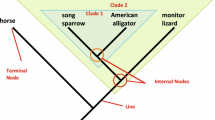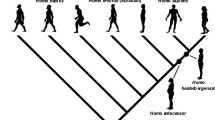Abstract
The biological community is currently undertaking one its greatest scientific endeavours, that of constructing the Tree of Life, a phylogeny intended to be an evidenced-based, predictive road map of evolutionary relationships among Earth’s biota. Unfortunately, we know very little about how such diagrams are understood, interpreted, or used as inferential tools by students—collectively referred to as tree thinking. The present study provides the first in-depth look at US high school students’ competence at tree thinking and reports how they engage cognitively with tree representations as a precursor to developing curricula that will provide an entry point into macroevolution. Sixty tenth graders completed a 12-question instrument that assessed five basic tree-thinking skills. We present data that show patterns of misunderstandings are largely congruent between tenth graders and undergraduates and identify competences that are pivotal to address during instruction. Two general principles that emerge from this study are: (a) Students need to be taught that cladograms are an authoritative source of evidence that should be weighted more than other superficial or ecological similarities; (b) students need to understand the vital importance and critical difference between most recent common ancestry and common ancestry. Further, we show how the objectives of this study are closely aligned with US and International Standards and argue that scientifically-literate citizens need at least a basic understanding of the science behind the Tree of Life to understand and engage in twenty-first century societal issues such as human health, agriculture, and biotechnology.




Similar content being viewed by others
References
American Museum of Natural History (AMNH). (2002). Assembling the Tree of Life: Harnessing Life’s History to Benefit Science and Society. Brochure produced for the National Science Foundation based on three NSF Tree of Life workshops held in 1999 and 2000 at Yale University, the University of California Davis, and the University of Texas Austin. http://www.phylo.org/sub_sections/outreach/outreach_b.php. Accessed 30 Aug 2010.
Baum, D. A., Smith, S. D., & Donovan, S. S. (2005). The tree thinking challenge. Science, 310, 979–980.
Bloom, B. S. (1956). Taxonomy of educational objectives. Handbook I: The cognitive domain. New York: David McKay.
Campbell, A., Otrel-Cass, K. (2011). Teaching evolution in New Zealand’s schools—Reviewing changes in the New Zealand science curriculum. Research in Science Education, 41(3), 441–451.
Catley, K. M. (2006). Darwin’s missing link: A new paradigm for evolution education. Science Education, 90(5), 767–783.
Catley, K. M., & Novick, L. R. (2008). Seeing the wood for the trees: An analysis of evolutionary diagrams in biology textbooks. BioScience, 58(10), 976–987.
Catley, K., Lehrer, R., & Reiser, B. (2005). Tracing a prospective learning progression for developing understanding of evolution. Paper Commissioned by the National Academies Committee on Test Design for K-12 Science Achievement.
Catley, K. M., Novick, L. R., & Shade, C. K. (2010). Interpreting evolutionary diagrams: When topology and process conflict. Journal of Research in Science Teaching, 47(7), 861–882.
Catley, K. M., Novick, L. R., & Funk, D. J. (2012). The promise and challenges of introducing tree thinking into evolution education. In K. Rosengren, E. M. Evans, S. Brem, & G. Sinatra (Eds.), Evolution challenges: Integrating research and practice in teaching and learning about evolution. Oxford: Oxford University Press
Darwin, C. (1859). On the origin of species by means of natural selection (1st ed.). London: John Murray.
Futuyma, D. J. (2004). The fruit of the tree of life. In J. Cracraft & M. J. Donoghue (Eds.), Assembling the tree of life (pp. 25–39). New York, NY: Oxford University Press.
Goldsmith, D. W. (2003). The great clade race. Presenting cladistic thinking to biology majors & general science students. The American Biology Teacher, 65, 679–682.
Gregory, T. R. (2008). Understanding evolutionary trees. Evolution: Education and Outreach, 1, 121–137.
Halverson, K. L., Pires, C. J., & Abell, S. K. (2011). Exploring the complexity of tree thinking expertise in an undergraduate systematics course. Science Education, 95, 794–823.
Hennig, W. (1966). Phylogenetic systematics. Urbana: University of Illinois Press.
Hillis, D. M. (2004). The tree of life and the grand synthesis of biology. In J. Cracraft & M. J. Donoghue (Eds.), Assembling the tree of life (pp. 545–547). New York: Oxford University Press.
Lee, M. S. Y., Reeder, T. W., Slowinski, J. B., & Lawson, R. (2004). Resolving reptile relationships: Molecular and morphological Markers. In J. Cracraft & M. J. Donoghue (Eds.), Assembling the tree of life (pp. 451–467). New York, NY: Oxford University Press.
Meir, E., Perry, J., Herron, J. C., & Kingsolver, J. (2007, September). College students’ misconceptions about evolutionary trees. The American Biology Teacher Online, 69(7), 71–76.
Ministry of Education. (2007). The New Zealand Curriculum for English-medium teaching and learning in years 1–13. Wellington: Learning Media.
Morabito, N., Catley, K. M., & Novick, L. R. (2010). Reasoning about evolutionary history: The effects of biology background on post-secondary students’ knowledge of most recent common ancestry and homoplasy. Journal of Biological Education, 44, 166–174.
National Research Council. (1996). National Science Education Standards. Washington: National Academies Press.
National Research Council. (2012). A framework for K-12 Science education: Practices, crosscutting concepts, and core ideas. Washington: National Academies Press.
Nickels, M. K., & Nelson, C. E. (2005). Beware of nuts & bolts: Putting evolution into the teaching of biological classification. The American Biology Teacher, 67, 283–289.
North Carolina Standard Course of Study. (2011). http://www.ncpublicschools.org/curriculum/science/scos/2004/23biology. Accessed Retrieved 18 Jan 2011
Novick, L. R., & Catley, K. M. (2007). Understanding phylogenies in biology: The influence of a Gestalt perceptual principle. Journal of Experimental Psychology. Applied, 13, 197–223.
Novick, L. R., Catley, K. M. (2013) Reasoning about evolution’s grand patterns: College students’ understanding of the tree of life. American Educational Research Journal, 50(1), 138–177.
Novick, L. R., Catley, K. M., & Funk, D. J. (2010a). Characters are key: The effect of synapomorphies on cladogram comprehension. Evolution: Education and Outreach, 3(4), 539–547.
Novick, L. R., Catley, K. M., & Schreiber, E. G. (2010b). Understanding cladograms: An introduction to tree thinking. Nashville: Department of Psychology and Human Development, Vanderbilt University. Unpublished instructional booklet.
Novick, L. R., Catley, K. M., & Funk, D. J. (2011a). Inference is bliss: Using evolutionary relationship to guide inferences about biological categories. Cognitive Science, 35(2), 712–443.
Novick, L. R., Shade, C. K., & Catley, K. M. (2011b). Linear versus branching depictions of evolutionary history: Implications for design. Topics in Cognitive Science, 3, 536–559.
O’Hara, R. J. (1988). Homage to Clio, or, toward an historical philosophy for evolutionary biology. Systematic Zoology, 37, 142–155.
Phillips, B. C., Novick, L. R., Catley, K. M., & Funk, D. J. (2012). Teaching tree thinking to college students: It’s not as easy as you think. Evolution: Education and Outreach, 5, 595–602.
Sandvik, H., (2008). Tree thinking cannot taken for granted: Challenges for teaching phylogenetics. Theory in Biosciences, 127, 45–51. http://www.springerlink.com/content/eu62420p381402xr/. Accessed 19 Mar 2008.
Thanukos, A. (2009). A name by any other tree. Evolution: Education & Outreach, 2, 303–309.
Yates, T. L., Salazar-Bravo, J., & Dragoo, J. W. (2004). The importance of the tree of life to society. In J. Cracraft & M. J. Donoghue (Eds.), Assembling the tree of life (pp. 7–17). New York: Oxford University Press.
Acknowledgments
We thank Randi Neff our collaborating high school teacher for her advice and insight and Jena Gladden, our research assistant, for her help collecting data. The research reported here was supported by the Institute of Education Sciences, US Department of Education, through Grant R305A080621 to Vanderbilt University. The opinions expressed are those of the authors and do not represent views of the Institute or the US Department of Education.
Author information
Authors and Affiliations
Corresponding author
Appendix
Appendix
Cladogram showing relationships among 10 placental mammal taxa (Fig. 1 in Novick and Catley 2013):
-
P1.
List all taxa (might be one or more) that evolved from an ancestor that had a single-chambered stomach.
-
P2.
Which taxon—giraffes or elephants—is the closest evolutionary relation to horses?
_______________________
Explain your answer:
-
P3.
A clade is a group that includes the most recent common ancestor of the group and all descendants of that ancestor. Do the bracketed taxa labeled “A” form a clade?
yes no (circle one)
Explain your answer:
If you answered no, which taxa need to be removed and/or added to the group to make it a clade? (Make sure you indicate whether the taxa you list should be added or removed.)
Cladogram showing relationships among 7 marsupial mammal taxa (Fig. 2 in Novick and Catley 2013):
-
M1.
What character was possessed by the most recent common ancestor of honey possums and brush tailed possums?
-
M2.
Which taxon—koalas or bandicoots—is the closest evolutionary relation to brush tailed possums? _______________________
Explain your answer:
-
M3.
A clade is a group that includes the most recent common ancestor of the group and all descendants of that ancestor. Do the bracketed taxa labeled “A” form a clade?
yes no (circle one)
Explain your answer:
If you answered no, which taxa need to be removed and/or added to the group to make it a clade? (Make sure you indicate whether the taxa you list should be added or removed.)
Cladogram showing relationships among 10 insect taxa (Fig. 4 in Novick and Catley 2013):
-
I1.
What character was possessed by the most recent common ancestor of fleas and butterflies?
-
I2.
Which taxon—dragonfly or butterfly—is the closest evolutionary relation to the walking stick? _______________________
Explain your answer:
-
I3.
Given that termites digest cellulose, which taxon is most likely to share this character? _______________________
Explain your answer:
Cladogram showing relationships among 10 dinosaur taxa (Fig. 3 in the present manuscript):
-
D1.
List all taxa (might be one or more) that did not evolve from an ancestor that had a reduced number of finger bones.
-
D2.
Which taxon—Plateosaurus or Diplodocus—is the closest evolutionary relation to Sellosaurus? _______________________
Explain your answer:
-
D3.
Given that birds are warm-blooded, which taxon is most likely to share this character? _______________________
Explain your answer:
Rights and permissions
About this article
Cite this article
Catley, K.M., Phillips, B.C. & Novick, L.R. Snakes and Eels and Dogs! Oh, My! Evaluating High School Students’ Tree-Thinking Skills: An Entry Point to Understanding Evolution. Res Sci Educ 43, 2327–2348 (2013). https://doi.org/10.1007/s11165-013-9359-9
Published:
Issue Date:
DOI: https://doi.org/10.1007/s11165-013-9359-9




